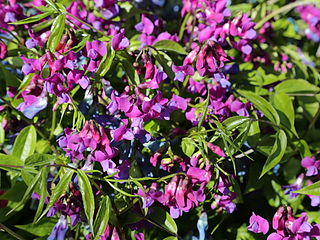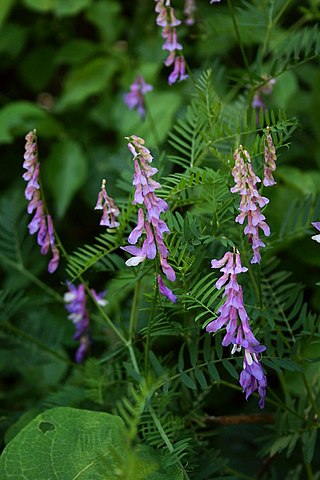
Forage is a plant material eaten by grazing livestock. Historically, the term forage has meant only plants eaten by the animals directly as pasture, crop residue, or immature cereal crops, but it is also used more loosely to include similar plants cut for fodder and carried to the animals, especially as hay or silage.

Vicia faba, commonly known as the broad bean, fava bean, or faba bean, is a species of vetch, a flowering plant in the pea and bean family Fabaceae. It is widely cultivated as a crop for human consumption, and also as a cover crop. Varieties with smaller, harder seeds that are fed to horses or other animals are called field bean, tic bean or tick bean. Horse bean, Vicia faba var. equinaPers., is a variety recognized as an accepted name. This legume is very common in Southern European, Northern European, East Asian, Latin American and North African cuisines.

Lathyrus is a genus of flowering plants in the legume family Fabaceae, and contains approximately 160 species. Commonly known as peavines or vetchlings, they are native to temperate areas, with a breakdown of 52 species in Europe, 30 species in North America, 78 in Asia, 24 in tropical East Africa, and 24 in temperate South America. There are annual and perennial species which may be climbing or bushy. This genus has numerous sections, including Orobus, which was once a separate genus. The genus has numerous synonyms, including Pisum, the ancient Latin name for the pea.

Cyclamen is a genus of 23 species of perennial flowering plants in the family Primulaceae. In English, it is known by the common names sowbread or swinebread. Cyclamen species are native to Europe and the Mediterranean Basin east to the Caucasus and Iran, with one species in Somalia. They grow from tubers and are valued for their flowers with upswept petals and variably patterned leaves.

Lathyrus latifolius, the perennial peavine, perennial pea, broad-leaved everlasting-pea, or just everlasting pea, is a robust, sprawling herbaceous perennial flowering plant in the pea family Fabaceae. It is native to Europe but is present on other continents, such as North America and Australia, where it is most often seen along roadsides.

Vicia cracca, is a species of flowering plant in the pea and bean family Fabaceae. It is native to Europe and Asia. It occurs on other continents as an introduced species, including North America, where it is a common weed. It often occurs in disturbed habitats, including old fields and roadside ditches.

Lathyrus pratensis or meadow vetchling, yellow pea, meadow pea and meadow pea-vine, is a perennial legume that grows to 1.2 m in height.

Vicia is a genus of over 240 species of flowering plants that are part of the legume family (Fabaceae), and which are commonly known as vetches. Member species are native to Europe, North America, South America, Asia and Africa. Some other genera of their subfamily Faboideae also have names containing "vetch", for example the vetchlings (Lathyrus) or the milk-vetches (Astragalus). The lentils are included in genus Vicia, and were formerly classified in genus Lens. The broad bean is sometimes separated in a monotypic genus Faba; although not often used today, it is of historical importance in plant taxonomy as the namesake of the order Fabales, the Fabaceae and the Faboideae. The tribe Vicieae in which the vetches are placed is named after the genus' current name. The true peas (Pisum) are among the closest living relatives of vetches.

Lathyrus japonicus, the sea pea, beach pea, circumpolar pea or sea vetchling, is a species of flowering plant in the legume family Fabaceae, native to temperate coastal areas of the Northern Hemisphere, and Argentina.

Lathyrus tuberosus is a small, climbing perennial plant, native in moist temperate parts of Europe and Western Asia. The plant is a trailer or weak climber, supported by tendrils, growing to 1.2 m tall. The leaves are pinnate, with two leaflets and a branched twining tendril at the apex of the petiole. Its flowers are hermaphroditic, pollinated by bees. The plants can also spread vegetatively from the root system.

Lathyrus niger, also known as black pea, blackening flat pea and black bitter vetch, is a perennial legume that is native to Europe. Its common name is reference to the blackening of the plant's foliage as it dies.

Lathyrus sylvestris, the flat pea or narrow-leaved everlasting-pea, is a species of flowering plant in the pea and bean family Fabaceae. It is native to parts of Africa, Europe, and Asia.

Vicia lathyroides is a plant species in the bean family Fabaceae. It is native to Europe and western Asia, and it is known on other continents as an introduced species. It is an annual herb with pealike blue- or purple-tinged flowers about half a centimeter wide and hairless legume pods up to 3 centimeters long.
Bitter vetch is a common name for several plants and may refer to:

Lathyrus vernus, the spring vetchling, spring pea, or spring vetch, is a species of flowering herbaceous perennial plant in the genus Lathyrus, native to forests of Europe and Siberia. It forms a dense clump of pointed leaves with purple flowers in spring, shading to a greenish-blue with age.

Lathyrus palustris is a species of wild pea known by the common name marsh pea. It is native to Europe, Asia, and North America. It is a perennial herb with leaves made up of oval-shaped or oblong leaflets a few centimeters long. It has branched, coiled tendrils. The plant bears an inflorescence of two to eight pinkish purple pea flowers each up to two centimeters wide. The fruit is a dehiscent legume pod.

Vicia orobus is a species of leguminous plant in the genus Vicia, known as wood bitter-vetch. It is found in Atlantic areas of Europe, especially in the rocky edges of seasonally-grazed fields. It grows up to 60 cm (24 in) tall, and has no tendrils at the ends of its pinnate leaves. Its flowers are white with purple veins, and are borne in groups of 6 or more.

Vicia grandiflora, commonly known as large yellow vetch and bigflower vetch, as well as large-flowered vetch, is a common herbaceous plant species in the family Fabaceae, which occurs as a native plant species in Europe and Asia, as well as an introduced vetch species in North America.

Vicia tenuifolia, the fine-leaved vetch,cow vetch, fodder vetch or bramble vetch, is a herbaceous perennial plant species in the family Fabaceae. This species is widespread in Europe and some parts of both Asia and Africa. In some other areas it occurs as an introduced species. In a few countries this edible vetch is used as food for both humans and farm animals.

Vicia bithynica known as Bithynian vetch, is a species of flowering plant in the bean family Fabaceae. It was described by Carl Linnaeus, initially as Lathyrus bithynicus but later moved to the genus Vicia (vetches). The specific name is derived from Bithynia, an ancient kingdom situated on the north coast of Anatolia, in modern day Turkey.



















